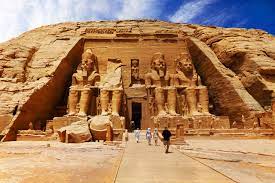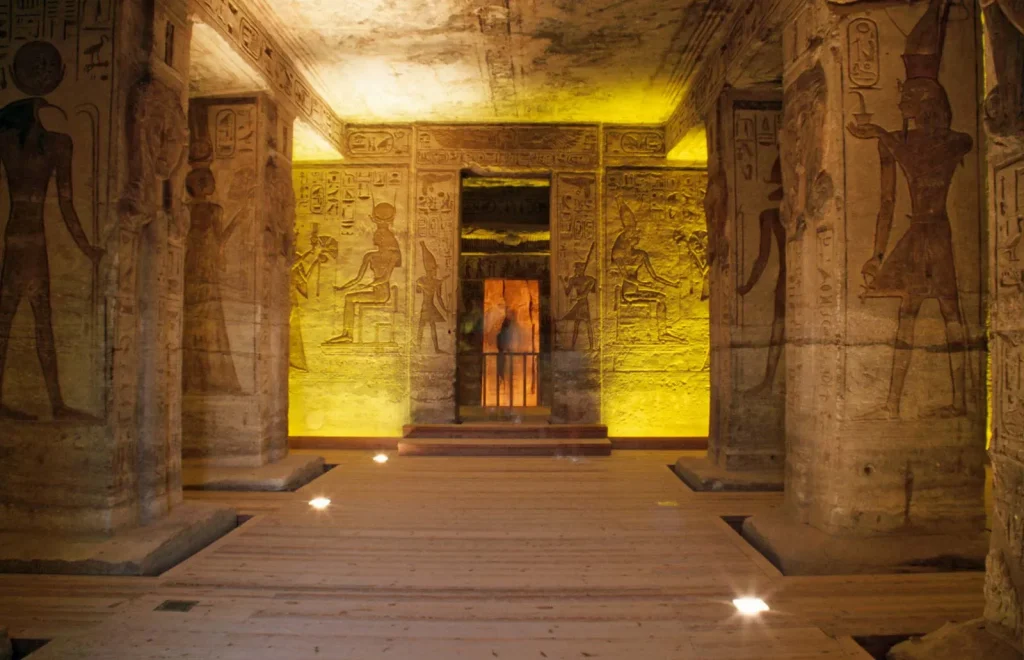Abu Simbel, a UNESCO World Heritage Site nestled on the banks of Lake Nasser in Egypt, has long captivated travelers with its awe-inspiring temples. The question lingering in many minds is, “Is Abu Simbel worth visiting?”
Historical Marvels in Stone

Abu Simbel’s Rich History
Built during the reign of Pharaoh Ramses II in the 13th century BCE, Abu Simbel boasts two grand temples: one dedicated to Ramses himself, and the other to his beloved wife, Queen Nefertari. Carved into the mountainside, these structures are a testament to ancient Egyptian architectural prowess.
Iconic Statues and Sacred Halls
The colossal statues guarding the entrance and the intricate carvings within showcase the devotion to deities and the pharaoh. The Great Temple, with its hypostyle hall, narrates tales of triumphs and divine connections. The precision and scale of construction leave visitors in awe.
The Journey to Abu Simbel
Remote Location and Accessibility
Abu Simbel’s remote setting enhances its allure but poses logistical challenges. Travelers often wonder if the effort is justified. The temples are reachable by air or a long drive from Aswan. While the journey might be arduous, the anticipation and the ultimate sight make it a pilgrimage for history enthusiasts.
Sun Festival: A Celestial Spectacle
A unique aspect that adds to Abu Simbel’s mystique is the Sun Festival that occurs twice a year. On these occasions, sunlight penetrates the temple to illuminate the inner sanctum, highlighting the statues of the gods. This celestial alignment creates a surreal spectacle, drawing crowds to witness this natural wonder.
Visitor Experience

Crowds and Timing
While the site is a marvel, its popularity brings crowds, especially during peak hours. To truly appreciate Abu Simbel, consider visiting during quieter times. Early mornings or late afternoons provide a more intimate experience, allowing for a deeper connection with the ancient wonders.
Guided Tours and Insightful Narratives
Engaging a knowledgeable guide can transform your visit. They unravel the historical layers, offering insights into the significance of each carving and the stories etched in stone. A guided tour enriches the experience, providing context to the intricate details that might be overlooked otherwise.
Is Abu Simbel Worth the Journey?
Awe-Inspiring Beauty Beyond Words
Standing in the shadow of these colossal structures, one can’t help but feel a profound connection with history. The intricate detailing, the monumental scale, and the spiritual ambiance create an experience that transcends the challenges of reaching this remote location.
Preserving Ancient Heritage
Beyond personal experience, supporting the preservation of Abu Simbel is crucial. Tourism contributes to the conservation efforts, ensuring that these ancient wonders endure for future generations. Your visit becomes not just a personal exploration but a contribution to the safeguarding of cultural heritage.
Is it worth it to go to Abu Simbel?
Absolutely, the journey to Abu Simbel is undeniably worth it. This UNESCO World Heritage Site offers a rare glimpse into ancient Egyptian grandeur. The temples, dedicated to Ramses II and Queen Nefertari, boast colossal statues and intricate carvings that narrate tales of triumphs and divine connections. The experience of standing in the shadow of these monumental structures is awe-inspiring, providing a profound connection with history. While the journey may be challenging due to its remote location, the rewards of witnessing Abu Simbel’s historical marvels make it a pilgrimage for history enthusiasts.
How much time do you need at Abu Simbel?
To truly appreciate Abu Simbel, plan to spend at least 2 to 3 hours exploring the site. The two main temples, the Great Temple and the Temple of Nefertari, are rich in detail and history. Factor in additional time for capturing photos, enjoying the surrounding landscape, and, if possible, attending the Sun Festival, a celestial spectacle that occurs twice a year. Arriving early in the morning or late afternoon can provide a more intimate experience with fewer crowds, allowing you to soak in the ancient wonders at your own pace.
Why is Abu Simbel so special?
Abu Simbel is special for several reasons. Firstly, its historical significance is unparalleled. Built during the reign of Pharaoh Ramses II in the 13th century BCE, the temples showcase remarkable ancient Egyptian architectural prowess. The colossal statues, intricate carvings, and hypostyle halls narrate tales of devotion, triumphs, and divine connections. Additionally, the Sun Festival, where sunlight illuminates the inner sanctum, adds a celestial touch, making Abu Simbel a unique and spiritually charged destination. Beyond personal experience, visiting Abu Simbel supports the preservation of cultural heritage, contributing to the conservation efforts that ensure these ancient wonders endure for future generations.
Is Abu Simbel closer to Luxor or Aswan?
Abu Simbel is closer to Aswan than Luxor. The temples are situated near the border between Egypt and Sudan, approximately 230 kilometers southwest of Aswan. While it’s possible to reach Abu Simbel by a long drive from Aswan, there are also flights available, making the journey more accessible. Luxor, on the other hand, is situated to the north of Aswan and is farther away from Abu Simbel. Therefore, if you are planning a visit to Abu Simbel, Aswan is the more convenient starting point for your journey.
Conclusion
In conclusion, the question posed at the beginning finds its answer in the profound beauty and historical significance of Abu Simbel. The journey to this remote site might be challenging, but the rewards are immeasurable. Abu Simbel is not merely a destination; it’s a voyage through time, a chance to stand in the presence of ancient greatness.
So, is Abu Simbel worth visiting? Absolutely. It’s a journey that transcends the ordinary, offering a glimpse into the grandeur of an ancient civilization that continues to captivate the world. Plan your visit, and let the stones of Abu Simbel whisper their tales of a bygone era.
